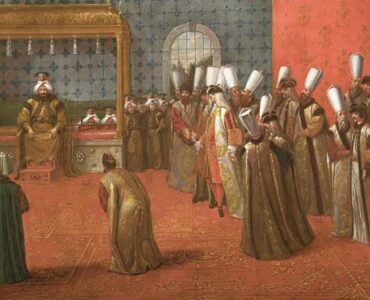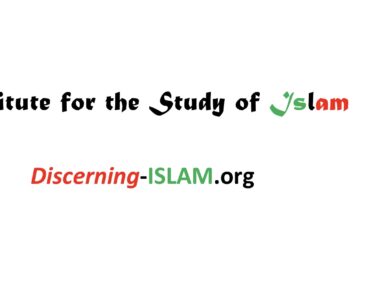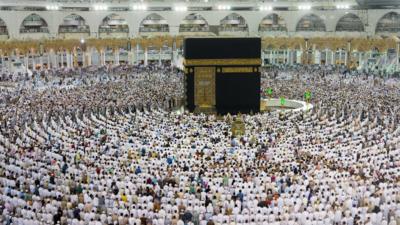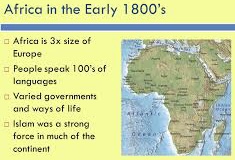
Islamic Calendar
The traditional Islamic (or Hijrah) calendar consists of twelve lunar months, each of which lasts from one first sighting of the crescent moon to the next. The twelve months of the Islamic calendar in order are Muḥarram, Ṣafar, Rabīaʿ al-Awwal, Rabīaʿ al-Thānī, Jamādī al-Awwal, Jamādī al-Thānī, Rajab, Shaʿbān, Ramaḍān, Shawwāl, Dhū al-Qaʿdah, and Dhū al-Ḥijjah. Because of the lunar nature of the calendar, each month lasts approximately 29 or 30 days. Thus the Islamic calendar, which is approximately 354 days long, shifts in relation to the 365-day solar year, with each month beginning ten or eleven days earlier each year. Furthermore, because the sighting of the moon may vary with longitude and latitude, the Muslim calendar also may vary from region to region. Because of this shifting nature of the Hijrah calendar, various solar calendars have also been used in the Muslim world. The solar year has advantages for administrative organization, in particular for the collection of agricultural taxes. The Hijrah calendar, however, is exclusively used for setting the months of the Islamic calendar and the associated important fasts and festivals of the Islamic ritual year.
The Islamic calendar maintains a seven-day week that runs concurrently with the Gregorian or universal solar calendar. As in the Jewish calendar, the days run from sunset to sunset rather than sunrise to sunrise. Friday (al-Jumuʿah) is significant in Islam as the day of jumuʿah or congregational prayers. Often businesses are closed on Friday afternoons so that men can attend congregational prayers at a mosque. Thursday is also important as a day of fasting for many Muslims. Shīʿī Muslims in India and Pakistan often attend religious assemblies (majālis) that are regularly held on Thursday evenings.
“Year One” of the Islamic calendar begins with the establishment of the first Muslim polity in Medina, following the migration or Hijrah of the prophet Muḥammad and his followers from the city of Mecca in 622 CE This year is thus designated as AH1 (After Hijrah). Because of the lack of concordance in length between the Muslim and universal solar calendars, it is not possible simply to add 622 to the Hijrah date to establish the common era (CE) date. The formula for converting these dates is as follows: the Hijrah date equals the Gregorian date minus 622 plus the total of the Gregorian date minus 622 divided by 32. Even this formula is somewhat inaccurate, and it is thus better to consult a conversion table or online calculator.
By orienting itself around the formative historical event of the Hijrah, which corresponds with the establishment of the first Islamic polity—rather than from the birth of Muḥammad or, as one might expect, from the first revelation of the Qurʿān — the Islamic calendar manifests the centrality of the ummah or community as a principle in Islam. It also expresses the importance of historical events in Islam — what the historian Marshall Hodgson has called “kerygmatic piety” — a piety that seeks to locate ultimacy in terms of irrevocable, datable, and nonrepeatable events. Kerygmatic piety is expressed in the days of the Islamic religious calendar that commemorate events that occurred during the formative period of Islamic history, such as the celebration of the birthday of the prophet Muḥammad and the martyrdom of his grandson Ḥusayn ibn ʿAlī. The Islamic calendar also designates as sacred certain days and months that, in contrast, are linked to no particular historical events. These dates correspond to the category of piety that Marshall Hodgson has called “paradigm tracing,” where ultimacy is sought in enduring and recurrent cosmic patterns. Such dates follow a cyclical pattern and are the opportunities for regularly established religious observances and festivals. Daily and weekly prayers follow this pattern. Similarly, the Islamic calendar reflects this type of piety in the yearly observance of Ramaḍān, the month of fasting, and the festival of ʿĪd al-Fiṭr that celebrates the final breaking of this fast, as well as in Dhū al-Ḥijjah, the month of the pilgrimage to Mecca, and its festival of ʿĪd al-Aḍḥā (or ʿĪd al-Qurbān), which commemorates the willingness of Abraham to offer his son Ismāʿīl (Ishmael) as a sacrifice. These “paradigm-tracing” festival months and days are shared by Sunnī and Shīʿī and are commemorated by both communities in similar ways with a few minor differences. In fact, for most Sunnī Muslims these two ʿĪds are the two major public religious observances of the Islamic ritual year.
The month-long fast of Ramadan takes place during the eighth month of the lunar year. During this period Muslims abstain from food, drink, smoking, and sexual contact from dawn until dusk. In some parts of the Islamic world the beginning of the fast is announced by groups of men who go from door to door through the streets of neighborhoods before the morning call to prayer, waking people so that they can prepare for the onset of the fast. The fast is broken each day around the time of the evening prayer with a small meal, often shared by family and friends. One activity recommended to pious persons is the recitation of the entire Qurʿān over the course of the month; to facilitate this the Qurʿān is divided into thirty equal sections called ajzāʿ (sing. juzʿ) or pāras (Persian, Urdu). Sometimes Shīʿī Muslims gather to hear discussions on religious topics during this period, particularly on the anniversary of ʿAlī ’s martyrdom on the twenty-first day of Ramaḍān, which is also a time for public processions. The first revelation of the Qurʿān on Laylat al-Qadr (the Night of Power) is commemorated by Sunnīs on the 27th and by Shīʿīs on the 19th, 21st, and 23rd. On this night, it is customary for pious Muslims to stay awake all night engaged in devotions. Many Muslims enter into a period of religious seclusion for ten days at the end of the month.
The fast of Ramadan concludes with the celebration of ʿĪd al-Fiṭr on the first day of the month of Shawwāl. Following the breaking of the fast Muslims gather in the courtyards of large mosques, called ʿīdgāhs in Persian and Urdu, to perform the morning prayers. The poor gather outside the mosque, as this is also a time when people distribute alms. In the afternoon families visit friends and relatives and distribute ʿĪd presents. On this day it is customary to dress in one ’s finest clothes and to distribute sweets, and also to pay one ’s servants and employees a bonus (ʿīdī). In general it is a festive day: not only has the disciplined and demanding fast come to an end, but those who have completed the fast believe that their sins are forgiven and thus feel assured of their admission to paradise.
The ḥajj, or pilgrimage to Mecca, takes place in the month of Dhū al-Ḥijjah, when millions of pilgrims go to Mecca and Medina to participate in the rites of the ḥajj. During the ḥajj, on the tenth day of Dhū al-Ḥijjah, ʿĪd al-Qurbān, also called ʿĪd al-Aḍḥā, is celebrated in the valley of Mina near Mecca where, in commemoration of the slaughtering of the lamb that God miraculously substituted for Abraham ’s son Ismāʿīl, pilgrims purchase and ritually slaughter an animal. Throughout the Muslim world it is customary for a family to similarly purchase an animal—a sheep, goat, or cow—and raise it for slaughter on the tenth day of Dhū al-Ḥijjah. In cities and towns huge livestock markets spring up to provide families with these animals; on the actual day of the ʿĪd, the animals are ritually slaughtered. Portions of the meat are distributed to the poor, and the rest is eaten in celebratory meals with friends and family.
The kerygmatic dimension of Islamic piety can be found in the numerous days that commemorate specific events in Islamic history. These include the birth and death anniversaries of important individuals and dates connected with important events in the first generation of Islam. The Twelver Shīʿīs celebrate many more of these days than do Sunnī Muslims. Not only do the Shīʿīs commemorate the birth and death anniversaries of the Prophet, his daughter Fāṭimah, and the twelve imams, they also observe other important events, such as Muḥammad ’s recognition of his son-in-law ʿAlī as his successor (mawlā) at the pool of Ghadīr Khumm during his last pilgrimage; the meeting between Muḥammad and his family and the Christians from Najrān at the Mubāhalah and most importantly, the month of Muḥarramī—specifically ʿĀshūrāʿ, the tenth of Muḥarramī—which, although clearly important to both Sunnī and Shīʿī Muslims, has special significance for Shīʿīs.
This Shīʿī emphasis on historical events is linked to their understanding of personal allegiance as a central element of their piety. Allegiance to Muḥammad is seen as a necessary corollary to allegiance and obedience to God. For Shīʿīs this extends to allegiance and obedience to Muḥammad ’s legitimate successors, the imams. The importance of allegiance to these individuals has resulted in rituals for the remembrance and evocation of the narratives of the lives of the Prophet and his family. Of all these events, the most significant is the martyrdom of the Prophet ’s grandson, Imam Ḥusayn ibn ʿĀlī, on the tenth of Muḥarram in 642 CE The month of Muḥarram is a time of daily ceremonies of public and private mourning, culminating on the tenth of Muḥarram in huge public assemblies and processions. During Muḥarram an atmosphere of deep mourning is established in Shīʿī neighborhoods. Shīʿī Muslims don black clothing and attend majlis where the events of Karbala are evoked and tearfully remembered. Processions are held in which replicas of coffins (tābūt) and tombs (taʿzīyah) are carried through neighborhoods as focuses of devotion. Some people physically mourn the death of the imam with breast-beating and self-flagellation. It should be noted that Sunnī Muslims also remember and honor the sacrifice of Ḥusayn, but there is less intensity and mourning, since devotion to the family of the Prophet is not as central to Sunnī piety as it is to Shīʿī.
There are also joyful celebrations in the Shīʿī ritual calendar. On the birthday of the Twelfth Imam, people write letters and place them in streams and rivers in the belief that the imam will receive these messages. In fact, the birthday anniversaries of all the imams are celebrated. On these occasions the assembly halls (called imāmbārahs in South Asia and ḥusaynīyahs by Persian speakers) are often brightly decorated with colored lights.
The Shīʿīs are not alone in the remembrance of historic events. For example, in modern times the celebration of the Mawlid al-Nabī or birthday of the prophet Muḥammad, which originated in the Fāṭimid period, has become increasingly popular among Sunnīs. In Pakistan and India large public processions on the twelfth of Rabīaʿ al-Awwal celebrate the Prophet ’s birth.
Another important element in the Muslim religious calendar is the celebration of the death anniversaries of Ṣūfī saints. In places as far-flung as Pakistan, Turkey, and Egypt, the tombs of the awliyāʿ (saints) are sites of frequent ziyārahs (pilgrimages) throughout the year and also of important celebrations known as mawlid or ʿurs. (ʿUrs is an Arabic word for “wedding” and signifies the spiritual wedding of the saint with his true beloved, God.) In South Asia large fairs are held in connection with these celebrations; their striking mix of sober piety and joyful celebration is often surprising to visitors who do not share the worldview of the participants. Merchants and professional performers — acrobats, motorcycle daredevils, and others — travel from tomb to tomb in order to participate in the highly profitable events surrounding ʿurs celebrations.
The Islamic calendar has important implications for Muslims in the modern world. Modernity has fundamentally altered the way people in the industrial world think of time. Work and leisure are now measured and defined as the periods in which people are either engaged or not engaged in industrial labor. The Islamic calendar was established in a preindustrial world where notions of work and leisure were more fluid and in tune with the natural progression of the seasons. The hegemony of the solar calendar has emerged concurrently with the hegemony of European industrial society, which has led some Muslim countries to modify their organization of time. Some governments have experimented with setting weekends on Saturday and Sunday, largely for economic reasons.
Modernity has also had implications for the Ramaḍān fast. Since the month of Ramaḍān migrates through the year, the fast sometimes takes place in the winter — when days are short and the weather is cool — and sometimes in the summer when the fast is particularly difficult. The requirements of labor in the modern industrial world make the fast a difficult ordeal for many Muslims who must work in great heat for long hours. Furthermore, fasting Muslims in urban environments often must travel long distances across cities, negotiating dense traffic in late afternoon heat while experiencing hunger and thirst. Tourism is also affected by the fast; for example, in Pakistan the iḥtirām-i Ramaḍān ordinances bring tourism to an effective halt by closing restaurants and beverage stands for Muslims and non-Muslims alike. Despite these added difficulties, large numbers of Muslims remain committed to the fast out of a deep sense of piety and a fervent desire to obey the commands of God.
The heterogeneity of modern Muslim communities in urban environments is also affected by the Islamic religious calendar and its festivals. Ordinarily, the distinguishing characteristics between Sunnī and Shīʿī, and to some extent even Muslims and non-Muslims, are invisible in daily life. However, during Muḥarram and other occasions of public performance, these normally invisible differences are brought to the surface, sometimes resulting in hostile confrontations.
For Muslims living outside the Muslim world, arranging for religious observances is made more difficult by the pressures of the solar calendar that determines the rhythm of the economy. In places where Muslims are a minority, public Muslim ritual performances may inflame the passions of non-Muslims who either do not understand or do not accept Muslim practices. For example, animal-rights activists in Europe have objected to the animal sacrifice of ʿĪd al-Aḍḥa. Similarly, in India Hindus have long objected to animal sacrifice, particularly of cows. On the other hand, Islamic performances — such as the yearly Muḥarram processions held by North American Shīʿī Muslims provide an opportunity for Muslims to share their faith with others and to present themselves and their religion to their neighbors.
Islamic Calendar
115 – 004
https://discerning-Islam.org
Last Updated: 03/2022
See COPYRIGHT information below.



